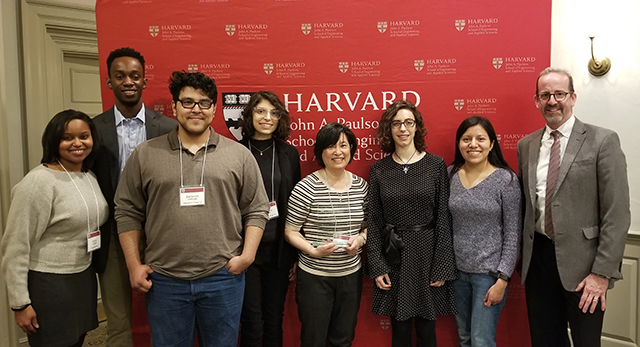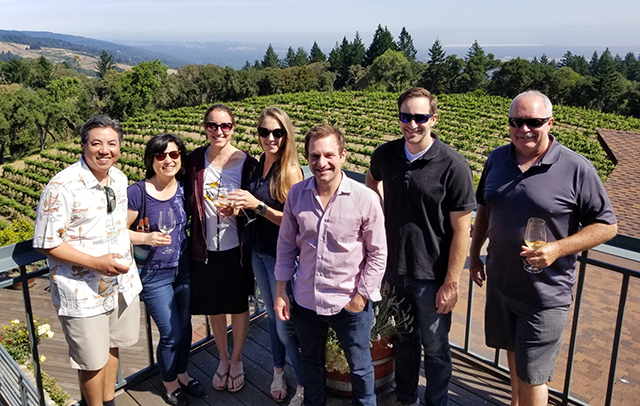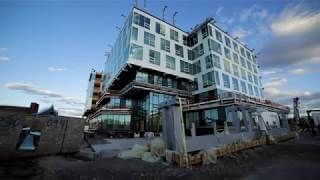Straight to the heart of biomedical entrepreneurship
The millions of patients who suffer from chronic venous insufficiency receive little relief from treatment. For these patients, malfunctioning vein valves can cause blood to pool at the bottom of their leg, often leading to painful ulcers. Available therapies are only stopgap measures, involving either wound-healing treatment of the ulcers or the use of pumps that squeeze the leg and temporarily relieve the pressure.
New technology developed by InterVene could get these patients back on their feet. The startup has developed an endovascular device that uses patients’ own venous wall tissue to create new vein valves in their legs.
The device essentially performs precise microsurgery on the end of a catheter, allowing for multiple new vein valves to be formed with a single procedure, explained Michi Garrison, A.B. ’83, InterVene’s vice president of research and development. She oversees the technical group, ensuring the design functions as intended and is properly tested for use in humans, while also directing the company’s intellectual property, operational, and quality functions.
“This project is exciting because there is an immediate impact. Even within 30 days, we are seeing patients who have less pain, and are able to walk around more easily,” she said. “It is so rewarding to be able to bring a therapy to patients who previously had no alternatives.”
Garrison was honored in April at a banquet celebrating excellence in engineering held during BRIDGE Week (building relationships, increasing diversity, and growing engineers) at the Harvard John A. Paulson School of Engineering and Applied Sciences (SEAS).

Garrison (fifth from left) was honored in April at a banquet celebrating excellence in engineering held during BRIDGE Week (building relationships, increasing diversity, and growing engineers) at SEAS.
She finds the technical challenges of this project especially intriguing, as it is more complex than the other biomedical products she’s worked on during her 30-year career.
Garrison’s math professor father inspired her to pursue a technical field, but it was a summer engineering program in high school that sparked a passion for biomedical technology.
“I thought it would be really cool to be able to design something that interacted with human physiology,” she said. “I was inspired by the possibility of creating medical devices that could help people.”
As an engineering concentrator, Garrison found herself fascinated by the mechanics of muscles and bones, and the fluid dynamics of blood flow.
Garrison pursued a bioengineering master’s degree at the University of California, San Diego, where she worked on a research project to mechanically model blood vessel walls. Inspired after hearing a lecture from the vice president of engineering at a medical device company, she began flipping through medical journals at the campus medical school library, sending her resume to companies that were making devices she found interesting.
She joined MiniMed Technologies as a product engineer, working on the optical and pressure sensors for a hospital infusion pump that combined three different IV pumps into one small instrument.
As her career advanced, Garrison held positions at several medical device companies, gaining experience as an engineer and manager. She was soon overseeing product development functions as director of R&D at startup Heartport, which was pioneering a method for open heart surgery without the need to open a patient’s chest. The startup eventually failed after it proved too challenging to incorporate so many new medical devices and techniques into one procedure.
“In this case, we just made things too complicated for the surgical team, and we didn’t succeed in getting adoption of the procedure we developed,” she said. “But I learned a lot of positive lessons, like how to foster good teamwork, how to enable teams to work together, and the importance of promoting mutual respect.”
Garrison drew on those lessons as she immersed herself deeper in the world of biomedical entrepreneurship. She later co-founded Silk Road Medical, a company that spun out of venture capital firm The Vertical Group to develop a device that made carotid stenting procedures faster and safer. (The company recently completed an initial public offering on the NASDAQ exchange.)
Garrison oversaw the engineering team as they developed a specialized sheath and flow control system which could be used to reverse the flow of blood from the carotid artery into a vein, enabling a physician to protect the brain from microparticles while inserting stents into the carotid artery.
“A sheath that was able to enter the carotid artery safely directly from the neck was new to physicians and new to us, so it took several iterations for us to find an effective design,” she said. “It was fun to work directly with physicians, try out the prototypes, and learn how to make it work properly.”

Garrison (second from left) and the InterVene team at a company outing at the Fogarty Winery. (Photo provided by Michi Garrison)
At InterVene, Garrison again finds herself juggling the development of a device with the need to understand the requirements of the procedure in which the device is used. Collecting and interpreting clinical data from the cases being performed, including complex hemodynamic measurements, is one of the biggest challenge she faces.
The firm, which has completed initial cases in Australia and New Zealand, is now seeking FDA approval for a U.S. clinical trial so they can gain more clinical experience, Garrison said.
She’s excited for the future of the company and the technology, and proud of how far the tiny firm has come. But if there’s one thing Garrison’s career in the medical device industry has taught her, it is to always be ready to innovate.
“When I first started, it was a little bit of the wild west out here. A lot of different things were being tried, and investors were funding all sorts of crazy ideas. Now, startup companies are spending their money in more focused ways, de-risking projects as early as possible,” she said, “I’ve become passionate about entrepreneurship, but at the end of the day, I really love designing new products. To be able to design something that interacts with a biological system is such an interesting challenge. And it is so gratifying to design something that could actually help a patient.”
Do you have an interesting story you'd like to share with your fellow alumni? We'd love to hear from you! Contact the SEAS Office of Communications.
